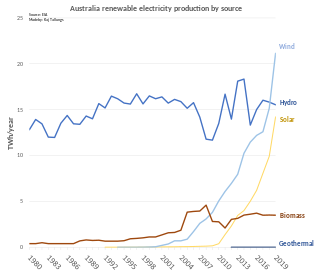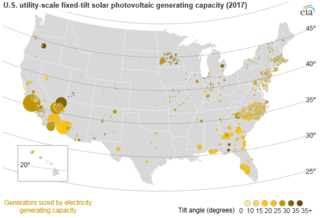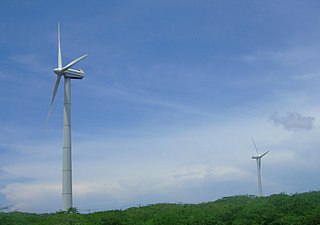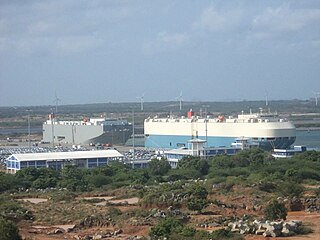
India is the third largest producer of electricity in the world. The national electric grid in India has an installed capacity of 403.759 GW as of 30 June 2022. Renewable power plants, which also include large hydroelectric plants, constitute 39.2 % of total installed capacity. During the fiscal year (FY) 2019–20, the gross electricity generated by utilities in India was 1,383.5 TWh and the total electricity generation in the country was 1,598 TWh. The gross electricity consumption in FY2019 was 1,208 kWh per capita. In FY2015, electric energy consumption in agriculture was recorded as being the highest (17.89%) worldwide. The per capita electricity consumption is low compared to most other countries despite India having a low electricity tariff.

Hambantota is the main town in Hambantota District, Southern Province, Sri Lanka. This underdeveloped area was hit hard by the 2004 Indian Ocean tsunami and is undergoing a number of major development projects including the construction of a new sea port and international airport finished in 2013. These projects and others such as Hambantota Cricket Stadium are said to form part of the government's plan to transform Hambantota into the second major urban hub of Sri Lanka, away from Colombo.

Many countries and territories have installed significant solar power capacity into their electrical grids to supplement or provide an alternative to conventional energy sources. Solar power plants use one of two technologies:

Renewable energy in Australia includes wind power, hydroelectricity, solar PV, heat pumps, geothermal, wave and solar thermal energy.

The Nellis Solar Power Plant is a 14-megawatt (MW) photovoltaic power station located within Nellis Air Force Base in Clark County, Nevada, northeast of Las Vegas. The power plant was inaugurated in a ceremony on December 17, 2007, with Nevada Governor Jim Gibbons activating its full operation. On average, it has since generated 32 gigawatt-hours of electricity annually and supplied more than 25% of the power used at the base.

Solar power includes utility-scale power plants as well as local distributed generation, mostly from rooftop photovoltaics and increasingly from community solar arrays. From January through December 2021, utility-scale solar power generated 114.7 terawatt-hours (TWh), or 2.79% of all generated electrical energy in the United States. During the same time period total solar generation, including estimated small-scale photovoltaic generation, was 163.7 TWh.

The Ivanpah Solar Electric Generating System is a concentrated solar thermal plant in the Mojave Desert. It is located at the base of Clark Mountain in California, across the state line from Primm, Nevada. The plant has a gross capacity of 392 megawatts (MW). It deploys 173,500 heliostats, each with two mirrors focusing solar energy on boilers located on three 459 ft tall solar power towers. The first unit of the system was connected to the electrical grid in September 2013 for an initial synchronisation test. The facility formally opened on February 13, 2014. In 2014, it was the world's largest solar thermal power station.

The Hambantota Wind Farm was a wind farm in Hambantota, Sri Lanka, owned and operated by the state-run Ceylon Electricity Board. The wind farm, which was located along south-eastern coast of Hambantota was the country's first state owned wind farm, and consisted of five NEG Micon M1500-600 wind turbines of 600 KW each. With a total installed capacity of 3 MW, the wind farm generated up to approximately 4,500 MWh of power a year.

Mahinda Rajapaksa International Cricket Stadium, also known as Sooriyawewa International Cricket Stadium, and abbreviately as MRIC Stadium, is an international cricket stadium in Hambantota, Sri Lanka. It was built for the 2011 Cricket World Cup and hosted two matches, the first being Sri Lanka against Canada, on 20 February 2011. The stadium has a capacity of 35,000 people making It the second largest stadium in Sri Lanka.

The Hambantota International Port is a deep water port in Hambantota, Sri Lanka. It was opened on 18 November 2010, and is Sri Lanka's second largest port, after the Port of Colombo. In 2020, the port handled 1.8 million tonnes of LPG and dry bulk cargo.

The electricity sector in Sri Lanka has a national grid which is primarily powered by hydroelectric power and thermal power, with sources such as photovoltaics and wind power in early stages of deployment. Although potential sites are being identified, other power sources such as geothermal, nuclear, solar thermal and wave power are not used in the power generation process for the national grid.

Sarnia Photovoltaic Power Plant near Sarnia, Ontario, is Canada's largest photovoltaic plant with an installed capacity of 97 MWP (80 MWAC).

The electricity sector in Switzerland relies mainly on hydroelectricity, since the Alps cover almost two-thirds of the country's land mass, providing many large mountain lakes and artificial reservoirs suited for hydro power. In addition, the water masses drained from the Swiss Alps are intensively used by run-of-the-river hydroelectricity (ROR). With 9,052 kWh per person in 2008, the country's electricity consumption is relatively high and was 22% above the European Union's average.

Warsak Dam is a mass concrete gravity dam located on the Kabul River in the Valley of Peshawar, approximately 20 km northwest of the city of Peshawar in the Khyber Pakhtunkhwa province of Pakistan.

Energy in Jordan describes energy and electricity production, consumption and import in Jordan. Jordan is among the highest in the world in dependency on foreign energy sources, with 96% of the country's energy needs coming from imported oil and natural gas from neighboring Middle Eastern countries. This complete reliance on foreign oil imports consumes a significant amount of Jordan's GDP. This led the country to plan investments of $15 billion in renewable and nuclear energy. To further address these problems, the National Energy Strategy for 2007-2020 was created which projects to boost reliance on domestic energy sources from 4 per cent to 40 per cent by the end of the decade.

Solar power in Florida has been increasing, as the cost of solar power systems using photovoltaics (PV) has decreased in recent years. Florida has low electricity costs compared with other states, which makes individual solar investment less attractive. Florida ranks ninth nationally in solar resource strength according to the National Renewable Energy Laboratory and tenth in solar generation by the Solar Energy Industries Association.

Renewable energy in Taiwan contributed to 8.7% of national electricity generation as of end of 2013. The total installed capacity of renewable energy in Taiwan by the end of 2013 was 3.76 GW. As of 2020, the Taiwan government aims for a renewable share of 20% by 2025, with coal and gas providing the other 80%.
The Maduru Oya Solar Power Station is a proposed 100 megawatt floating solar photovoltaic power station to be built over 500 acres (2.0 km2) - or 2%, of the Maduru Oya Reservoir. Following the cabinet approval in 2017, the Ministry of Science and Technology has allocated Rs. 80 million(about US$ 522,000) for obtaining of required equipment and materials for a prototype training project.
The Sagasolar Power Station is a solar photovoltaic power station built next to the Hambantota Solar Power Station, in Hambantota, Sri Lanka. The solar farm is owned and developed by Sagasolar, a joint venture between LOLC Group and Faber Capital Limited, with 70% debt funded by DFCC Bank, Commercial Bank of Ceylon, and Hatton National Bank. The 10-megawatt facility is expected to generate approximately 19GWh annually for at least 25 years.

















